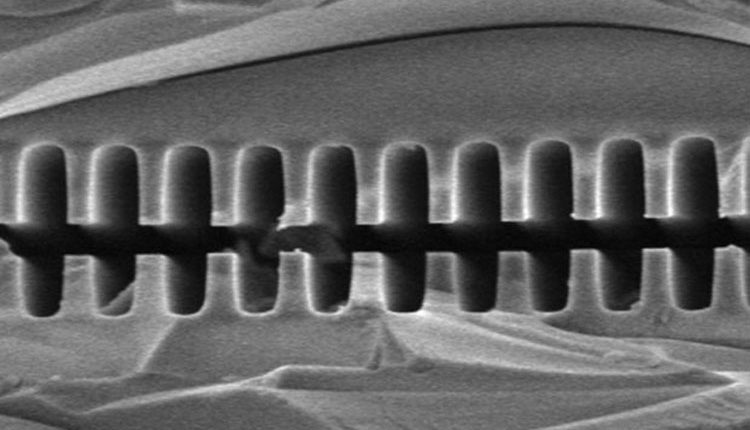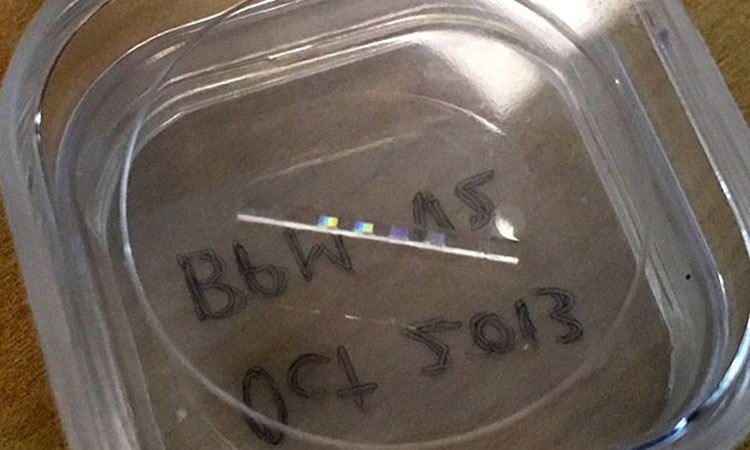Accelerator-on-a-chip could have profound impact on medicine
The Gordon and Betty Moore Foundation awarded $13.5m to a five-year project involving an international collection of universities and national labs to start work on shrinking particle accelerators so that they could fit on a chip about 15 months ago. The project, dubbed ‘Accelerator on a Chip’ could have a profound impact on both fundamental science research and medicine.
In a nutshell, the aim is to use lasers and a piece of nanostructured silicon or glass about the size of a grain of rice to accelerate electrons at a rate 10 times higher than conventional technology can. The resulting technology could potentially match the power of SLAC’s 3.2km-long linear accelerator in as little as 30m.
In a visit to the offices of Joel England, a fellow at the Advanced Accelerator Research Department at SLAC and one of the leaders of the Accelerator-on-a-Chip project, we got some insights into the science and technology involved and how it is proceeding.
“The idea actually originates in the 1960s, shortly after the laser was first invented, in a paper by [University of Tokyo laser pioneer Koichi Shimoda] that proposed to use a laser as a means to accelerate charged particles to high energy,” said England. “At the time, the technology didn’t really exist to actually realize it, but since then we’ve had the development of nanofabrication technology to make very tiny devices and solid-state lasers which are now very efficient.”
England explains that the Accelerator-on-a-Chip project has been able to harness these converging technologies of nanofabrication and solid-state lasers and combine them in order to make a miniaturized particle accelerator. While a variety of techniques for accelerating particles using this type of approach have been proposed over the years, according to England, it’s only become possible to realize it within the last three years because of the large amount of progress made in fabricating nanostructures and testing them.
In terms of operation, the miniaturized accelerometer works on the same basic principles of today’s large-scale particle accelerators. These accelerators use metallic, microwave cavities to speed up the electrons.
The connection with the miniaturized version is that the scientists are basically scaling down the power source from microwaves—which have wavelengths measured in centimeters—to lasers, which have wavelengths on the order of a micrometer. That’s a 10,000 fold difference.
“So it’s a big change in scale,” said England. “It shrinks down the size of the structure by that amount as well.”
Not only has the size of the structures been shrunk but also different types of materials are needed. Instead of using metal cavities, the miniaturized structures are fabricated from dielectrics—essentially different types of glass—that are optically transparent so you can you can get laser light to go through them.
If the nanostructures carved into the glass are designed correctly, when light passes through them, they will generate an electric field that gives a kick to charged particles as they’re going through.
You can see England offer a description of how the nanostructures use the laser light to excite the electrons in the video below.
The key to this all working is the design of the nanostructures. If you just have a laser in free space, the particle will just oscillate back and forth, pushing it one way and then the other. It won’t ever gain in total energy. So you need some kind of structure that channels or modulates the fields in such a way that the particle will travel along mainly the peaks of the electromagnetic wave and not into the troughs so that it gets kicks but not deceleration.
In all of the experiments done so far, England explains that the particles are basically filling the whole wave, occupying and seeing both the peaks and troughs. This results in some particles being accelerated while others get decelerated.
“In the future, as one of the next experimental steps what we want is to bunch the particles to make very short little packets of particles that are spaced at exactly the right distance between the peaks so that they will ride only on the peaks,” said England. “So you can think of it as like… ocean waves, and you want your surfers to be positioned only on the peaks of the waves and not in the troughs.”
While I was speaking to England, the research team at the University of California Los Angeles were testing how best to angle the laser toward the electron stream.
England describes the arrangement as a stream of particles passing through a narrow tunnel, and you want these particles to stay in contact with the laser field as long as possible. But if the laser pulse is a very short time, as the particle comes through the tunnel, then it will only see the laser very briefly. The electrons will continue to travel through the structure, but there’s no laser exciting them.
While you could make the laser pulse longer, the intensity of the laser will be reduced, resulting reducing the amount of acceleration the electrons experience.
“Another technique is you keep the short pulse but you sweep it. Tilt it,” explained England. “So the laser is traveling with a tilted angle as it goes through the electron stream. If you adjust that angle correctly, then as the particle goes through it’s hitting that beam a lot longer than it would if the laser was just coming directly at it.”
The practical benefits of shrinking a particle accelerator down to the size of chip are pretty self-evident. By making it chip scale leads to manufacturing costs being significantly less. It would also make it possible to produce hundreds or thousands of them very quickly. You can even imagine having a disposable accelerator so that when a part of it breaks, you plug in another chip.
There are enormous costs and size benefits where you could have portable versions of what are now large and heavy and cumbersome devices like a medical linear accelerators.
“In radiation therapy for cancer treatment, medical linear accelerators weigh about 10,000 pounds and cost around $3m,” says England. “So if you could make it with a microchip and have a very tiny device that’s portable, all you would need to do is plug a fiber laser into it to power it. This could lead to this therapy being used in a lot more settings and in areas of the world where there were cost restrictions on purchasing therapy devices like that.”
One of the key parameters for accelerator performance is the acceleration gradient, which is the energy—measured in megaelectron volts—gained per meter of travel. Conventional linear accelerators, like the one at SLAC have acceleration gradients of around 30–50MeV/m.
The goal of the five-year project is to get to 1MeV/m of acceleration, which would be a basic demonstration of the viability of the technique to make particles with energies that are that are useful for other things. The highest energy gain yet was achieved in the original SLAC experiment in 2013 described in Nature, which was around 150 kiloelectron-Volts (KeV)—a reasonable fraction of one MeV of acceleration.
“Once you get into a million electron volts or more then you’re sort of in the regime of where you can have practical applications; where something like a medical accelerator is more viable,” said England. “So typically for cancer treatment you’re using particles with between 1 and 20 million electron volts of energy.”
One of the phenomena that these chip-scale accelerometers lend themselves to is the creation of small bunches of electrons. These bunches take on an attosecond time structure. This natural inclination of attosecond time structures of electrons could be used to make attosecond x-rays, according to England.
These very short pockets of x-rays would then allow you to probe chemical reactions and other events on extremely short time scales.
“One of the dreams is to make molecular movies, or something where you capture the state of a molecule at different times in its evolution and do that in a very short time scale,” said England. “So you can actually see how molecules change as they react or combine with other molecules.”
Such an ability England likens to going from a camera where you take a picture once every few seconds to having a very high-speed camera where you can capture a water droplet landing on a beetle.
England and his colleagues still have four years left in this phase of the research. If the initial results are any indication, we can expect that applications may not be too far off in the future.



Comments are closed, but trackbacks and pingbacks are open.